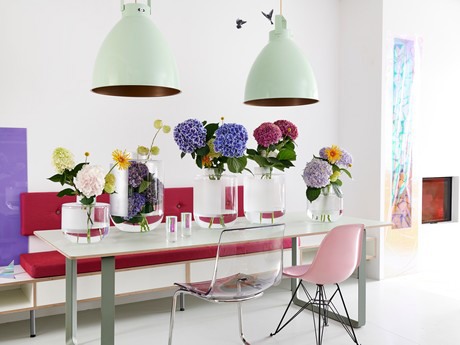Fresh green, bright white, sky blue, deep purple, lilac and pink. Flowers that can have a diameter of up to 25 cm that are shaped like fluffy clouds - the hydrangea is the ultimate symbol of high summer, the period of hot days, long evenings and sultry nights. When everyone takes it a bit easier. Hydrangea’s soft round shapes fit with this and can easily be included in arrangements to provide a soft landing.

Credit: Funnyhowflowersdothat.co.uk
Origin
The hydrangea is a member of its own hydrangea family. The ancestral species Hydrangea macrophylla, from which most cultivars are derived, grows along the coast south of Tokyo in large numbers. The flower, which originates from Asia, arrived in Europe with the first Dutch East Indies Company ships and became popular in around 1735, surprisingly both in castle gardens and alongside farms.
Assortment
The most common hydrangea is Hydrangea macrophylla with its globe-shaped blooms. There are both single-flowered and double-flowered varieties, from small ones with a diameter of 8-10 cm to very large with a diameter of 25-30 cm. H. macrophylla is available in dozens of cultivars in white, pink and green through to blood red and bi-coloured. The grower can turn the flowers blue by adding special substances to the water. In addition to single coloured flowers, there are also bi-coloured varieties. A total of some 150 different cultivars are available in August. The colour-changing hydrangeas are also available in that month for real enthusiasts. In addition to the cut flower with the round flower clusters, growers also offer Hydrangea paniculata with white and green plume-shaped flowers.
Inspiration & information
Inspiring images of every flower on the Flower Agenda have been produced in line with the Horticulture Sector Trends 2019 (Groenbranche Trends 2019). These trends are a translation of the latest consumer trends and are specifically aimed at the horticulture sector for use both indoors and outdoors.
For more information:
Funnyhowflowersdothat.co.uk
